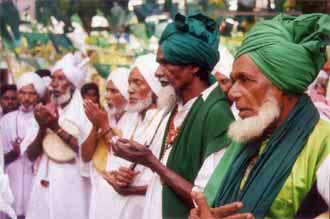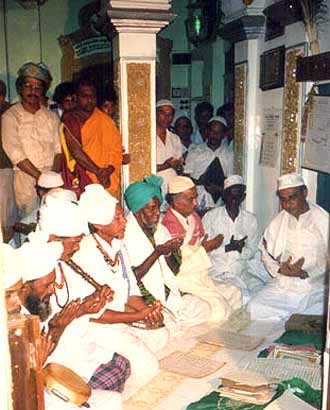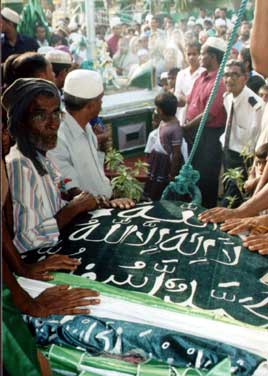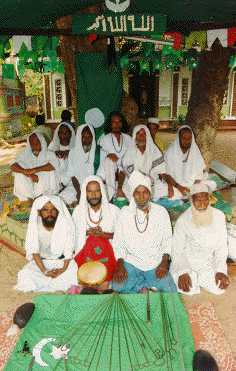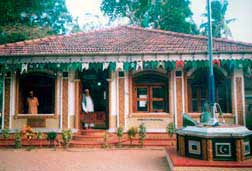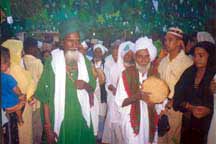|
| ||||||||||||||||||||||||||
Kataragama the 'Home of al-Khidr'
In 1888 Dr. M. Covington 733 wrote that the 'Mahomedans' who visit Kataragama temple asserted that "there is a hidden spring in the immediate neighbourhood, close to the bed of the river, the water of which has the power of rendering life immortal, as it did to one of their saints named Kadra Nabi, who had first discovered and drunk of it." He adds that under this impression, they have also a small monument close to the temple of Valli Amma dedicated to their saint, and take also a part in their own way, in the celebration of this festival, burning incense and saying prayers every night. To this day, many such rituals continue. The ceremony itself is known as the Kataragama Makām Ceremony, and evidently takes its name after the maqām or shrine of Khidr situated in the Muslim quarter of Kataragama not far from the Menik Ganga. The shrine known as Khalir Makām or 'Khidr's Sanctuary' is so called as it is believed that Khidr's mysterious presence pervades the shrine. However, as the trustee of the shrine, Abdul Gaffar informed us, Khidr is like air, when one thinks of him, he is there.734 The shrine, it is said, had been in existence for a long time, firstly in a most crude form consisting of just one wattle and daub room called 'Khizar room' hardly 15 feet by 15 feet.735 It was however not very long before miracles came to be attributed to that mysterious being after whom it had been named, not only in Sri Lanka but also in South India where we have a Tamil text, the Kanzul Karāmat claiming that a famous 16th Century Indian saint, Shawl Hamid, was mysteriously brought over to Sri Lanka by Khidr and placed on the banks of the Menik Ganga where in the company of angels, the robe of Kutbul Akhtab was conferred on him.
The Makām ceremony coincides with the Asala festival of Kataragama and lasts 16 days commencing with the kodi-ettram or flag-hoisting and followed by daily mawlud recitals and nightly rifāi ratibs before concluding with a grand kanduri feast. [Homage is particularly paid to him in the form of the mawlud recitals during this period. It is said that in the olden days, the Muslims here resorted to what is known as 'shrine worship'. They would keep vows and holding their ears go round the shrine seven times. They would also request the awliyā or saints directly for favours. Although these heathen practices have since been purged from the sanctuary, we noticed that many women resorting to the shrine still took oil from a lamp surmounted by a crescent which they applied on the hair of their offspring, a practice which would be considered rather unislamic by orthodox Muslims. 736 It is however not thought necessary that one should resort only to Kataragama in order to make vows to Khidr. Munck (1993) for instance found that the inhabitants of a Muslim village in the Monaragala District proferred a vow to Hyatt Nabi (i.e. Hayatun Nabi or Khidr). The vows were made prior to the sowing of paddy seed and fulfilled after the harvest when each family in the village would bring banana leaves filled with sweet rice to the mosque where it would be distributed among those present. Indeed, it is said that in the olden days, the entire Eastern region of the island with Kataragama as its centre was often referred to as the 'Khizar region' and that the hamlets surrounding Kataragama were regarded as places receiving the patronage and blessings of 'Hazarat Khizar'. 737 The influence of the Khidr cult in the country is also apparent in the writings of Ibn BattOta as far back as the le century where we find him mentioning the cave of Khizr where the pilgrims to Adam's Peak left their belongings before ascending to its summit. He even mentions a spring also called after Khizr and full of fish which no one catches. There has been considerable dispute among Muslim commentators as to who Khidr is. Some say he is a prophet while others say he is a wali, meaning one close to God, in other words, a saint. There can however be little doubt that it is he who figures in the Qur'an as the unnamed servant of God who initiates Moses into the mysteries or rather paradoxes of life. The Holy Book in Saratul Kahf or the Chapter of the Cave has it that this servant of Allah was taught by the Almighty out of his own knowledge (min ladunna ilm) and that Moses in turn requested him to teach him something of that divine knowledge. Moses proceeded to travel with him, only to find his companion committing three seemingly unjust deeds, scuttling a ship, killing a boy and repairing a well for an inhospitable people. On being questioned by Moses, his unnamed companion gives him three valid reasons why he had committed those deeds, providing an interpretation of those matters of which Moses was unable to grasp. Thus the scuttling of the ship is explained as a prevention to its seizure by a certain king, the killing of the youth because he would oppress his parents by rebellion and disbelief and the repairing of the wall because beneath it lay a buried treasure to which two orphans were entitled, their father having been a righteous man. The story seems to imply that this mysterious being was bestowed with knowledge ordinary mortals were unable to comprehend.
Who he was is clearly mentioned in a hadith or saying of the Prophet recorded in Bukhāri where he figures in an episode identical to that related in the Qur'ān. He is here called Al-Khadir and described as a man covered with a garment. Another tradition of the Prophet recorded in Bukhāri has it that Khidr was so named, because if he sat over a barren white land, it turned green with vegetation. This belief is also reflected in the Alf Layla Wa Layla where we have an allusion to Al-Khidr planting a pomegranate tree which forthright grew up and foliaged, flowered and fruited. Around this mysterious personage has grown a number of folk beliefs in various parts of the Muslim world, especially in Asia Minor, the Near East and the Indian subcontinent. The mystical tradition of the Sufis has it that he is immortal, having drunk of the Maul Hayat or 'Water of Life' 738 though one wonders how this could be reconciled with the statement in the Qur'ān that every soul shall taste of death. In Turkey, Khidr is known as Hizir and is said to appear before human eyes in the form of a frail old dervish with a long white beard. He is regarded as the patron saint of travellers, protecting them from the hazards of the road and is also said to rescue men from disaster. In India, Khidr is known as Khizar. He is said to have discovered the water of life and is considered the saint of waters. The Indian Muslims of yore even went to the extent of offering oblations of lamps and flowers to him placed on little rafts and launched on the river, particularly on Thursday evenings in the month of Bhadon. 739 It is evident here that the beliefs and rituals that have grown round Khidr in these countries are somewhat different from those existing in Sri Lanka where considerable South Indian influence such as in the case of the flag-hoisting is evident.
More about the Kataragama Devotees Trust
| ||||||||||||||||||||||||||
